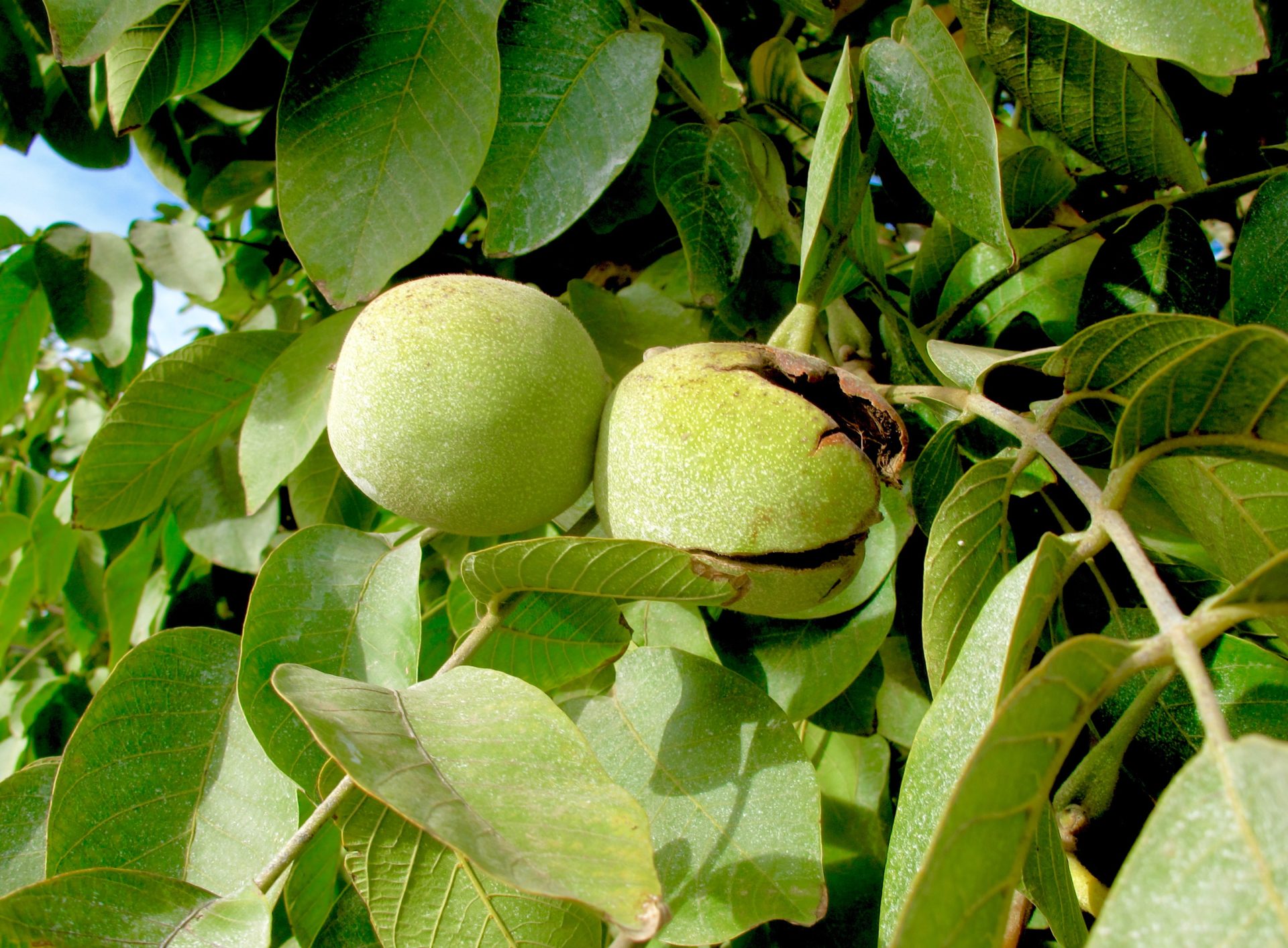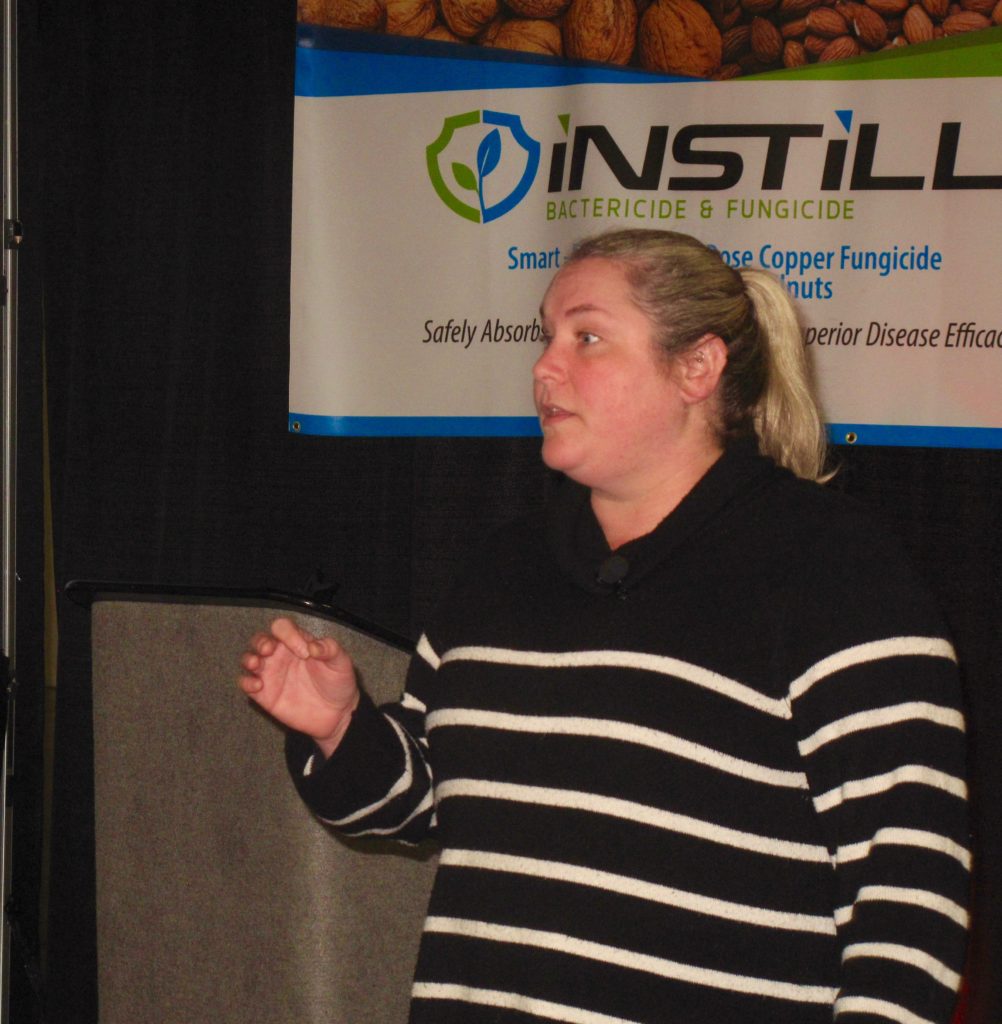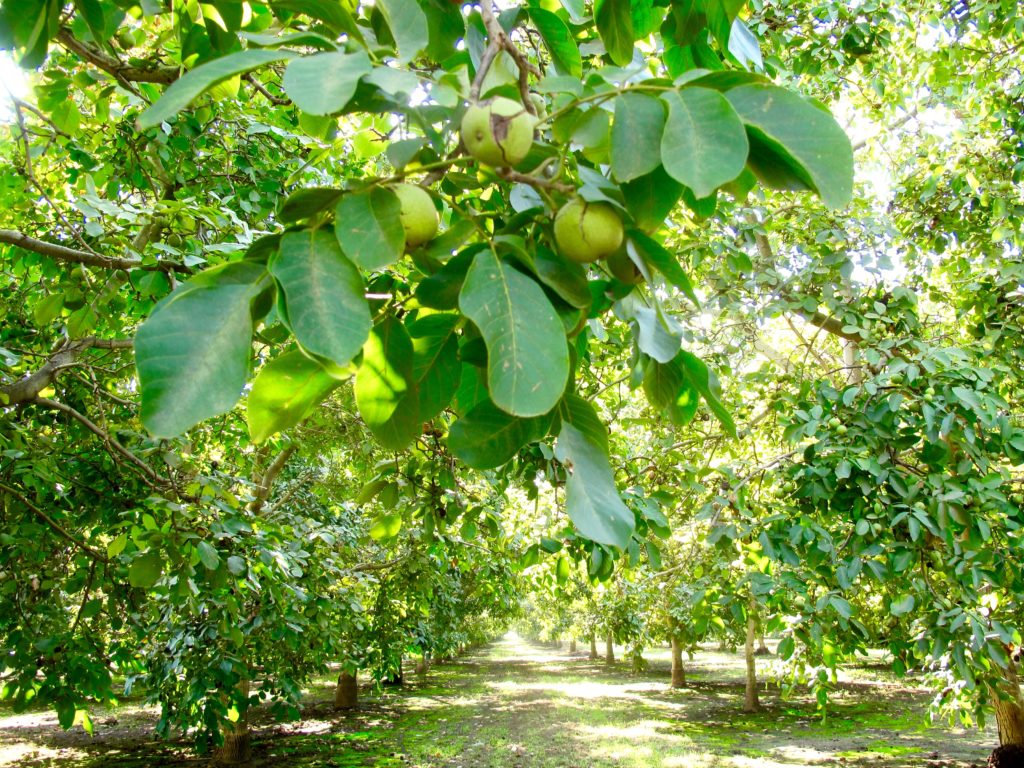
Contiguous acreage of nut crops in California is making navel orangeworm (NOW) a more pressing pest concern for walnut growers, according to Emily Symmes, Sacramento Valley area IPM advisor with the UC Statewide IPM Program and Cooperative Extension.
“Navel orangeworm has a broad host range and availability in the state, with tree nuts among the preferred hosts,” Symmes said. “And we are seeing expanded, contiguous acreage in tree nuts of almond, walnut and pistachio, up nearly 50 percent in bearing acreage over the last decade.”
The contiguous acreage makes NOW movement and spread a significant threat to nut crops.
“What we (researchers) did is we mapped the walnut, almond and pistachio acreage in the state,” Symmes said. “In the Central Valley we see this expanding continuous acreage of nut crops prime for NOW.”
She explained this pattern creates a staggered crop phenology, “which means we have this continuing available host and susceptibility period.”
Importance of Sanitation
Enhancing the NOW cycle in orchards are mummy nuts—those left over from last year that remain in trees—or any of the in-season damaged nuts. NOW have a high dispersal capacity, with the ability to fly up to six miles a night. This is a real challenge when it comes to management of the pest, Symmes said. They also have a high reproductive capacity with each female capable of laying 80 to 100 or more eggs.
“We have seen a single female lay as many as 200 eggs,” Symmes added.
Multiple larvae can develop in a single nut so one leftover mummy nut, or one in-season damaged nut can bear multiple larvae.
“We have seen as many as 10 larvae developing on a single nut,” she said.
NOW life cycle depends on mummy nuts for overwintering, whether its walnut, almond or pistachio. Mummies provide an overwintering bridge to get NOW from one season to the next, and can allow early generations to infest orchards before the in-season crop becomes vulnerable. In-season crop susceptibility occurs in damaged nuts and at husk or hull split.
The nut industry has an extremely low tolerance for crop damage, less than 2 percent, out of food safety concerns with aflatoxin.
“Effective management depends on sanitation, minimizing damage from other sources, harvest timing, insecticides and mating disruptions,” Symmes said.
Management challenges related to economics and logistics (control over harvest timing and insecticide timing, for example) must be addressed through an integrated approach.
“It really goes back to the map of the continuous-host smorgasbord,” Symmes said. “We really have to take an area-wide IPM approach to this pest based on its biology, ecology, and ability to readily move between hosts over significant distances.”
Four Generations a Year
Navel orangeworm produce four generations per year now, and this is the norm statewide, according to Symmes.
“It used to be that it would sometimes happen in the Sacramento Valley, but we can pretty well count on four generations most years now, partly due to earlier springs and summer heat,” she added.
The first and second flight on walnut are going to cycle through last season’s mummies and in-season damaged nuts.
“However, the impact of the third and fourth flights on the harvestable walnut crop depends on what variety you have, husk split and harvesting timing, how abundant the navel orangeworm population is, and how much migration into the orchard is occurring,” Symmes said.
Research and Projects
“So often I hear the question, ‘I’m trapping, and these are the numbers I’m seeing in my traps, do I need to treat my walnuts now, or when, and with what, to avoid certain crop damage,’” Symmes said. “So, we have been looking into what monitoring tools are available and what information they are telling us. That really is the million-dollar question that I wish I could answer. Our research is working towards being able to answer that question.”
That is why Symmes and her team – Houston Wilson, IPM specialist, Kearney/UCR; Chuck Burks, USDA entomologist; and Jhalendra Rijal, Northern San Joaquin Valley Area IPM advisor – are working on current projects evaluating a number of monitoring tools to learn how to best predict damage and when intervention is needed to avoid damage.
They are also conducting research on what factors influence NOW populations and damage in walnut orchards by focusing on the movement of NOW between crops and landscape and relating traps counts to harvest damage and figuring out what other factors should be included in a damage “risk model.”
Monitoring with Traps
There are three main trap-based monitoring tools for NOW that have been included in current research for adult NOW – kairomone for gravid (mated/egg-carrying) females, phenyl propionate (PPO) for males and females, and pheromone for males.
“For treatment thresholds it remains unclear for all three monitoring traps. This is one of those things that is a puzzle. You use different types of traps and other measures of risk in the environment and that is how you decide whether or not to treat,” Symmes said.
Current research shows that fewer pheromone traps are needed per block compared to kairomone and PPO traps. In addition, Symmes said, “Pheromone traps may be telling you more of a landscape scale, more of what is going on in general amongst the flight. The kairomone and PPO traps may be more tied to local population pressure and the damage potential in that orchard or block.”

Movement Between Orchards
In a 2018 study to determine moth origin, researchers trapped NOW in adjacent almond and walnut orchards in the center of the orchards using different trap types to see what was being caught and where. Analyzing the fatty acids in the captured moths, researchers learned the male moths moved between orchards during the duration of trapping.
“With the females, using the Peterson traps, we found a similar thing, while there was some movement between orchards, what we learned is that most of the females trapped in an orchard had developed from larvae in that orchard. That said, later in the season we saw an apparent influx of females into the walnut orchard from the almond orchard, much more than movement from the walnut into the almond orchard,” Symmes said.
The possible reason, she explained, is that later in the season the females are looking for someplace to lay their eggs. In August, almond orchards are being shaken and the females are losing that host, so they move over to an adjacent or nearby host, in this case a walnut orchard. At the same time the males aren’t worried about the orchard, they are just looking for the females.
“It is also important to note in this study that we learned that it is often a misconception that ‘all of NOW entering into my walnut are flying in from the almond orchard next door.’ And certainly we see that while this is significant, growers need to understand they still have their own in-house population of NOW in walnuts,” Symmes added.
She reported that results from the study are consistent with the hypotheses that NOW pheromone traps (for males) have a greater trapping radius than ovipositional bait traps (for females), and that female-based trap counts may provide more block-specific data and a greater association with ultimate crop damage. Evidence of the second phenomenon has also been observed in almonds. (Rosenheim et al., December 2017, Journal of Economic Entomology).
In a practical sense, Symmes asked, what do results of this research mean for monitoring NOW in walnut orchards as a decision-support tool for deciding whether to apply husk split treatments? Utilizing a combination of adult trap types may provide the best two-pronged information: (1) pheromone traps for male NOW to inform season-long activity (e.g., population detection, flight patterns, relative abundance), and (2) ovipositional bait bag traps for female NOW or PPO traps for males and females to inform site-specific pressure and damage potential.

2019 NOW Research
“We are looking at what these different NOW traps are telling us throughout the season and really trying to analyze the relationship between moth counts, harvest damage and these different trap types and determine where the moths are coming from over the course of the season,” Symmes said. “We also want to compare seasonal changes in NOW source and abundance in walnut orchards in the context of landscape-scale factors such as comparing almond dominant versus walnut dominant landscapes.”
Selected 2019 research regions included the Sacramento Valley, San Joaquin Valley-North and San Joaquin Valley-South. Within each region there were three walnut dominant sites and three almond dominant sites, totaling 18 sites of research altogether. Within each site three trap types have been established – one pheromone, one PPO and six kairomone, each monitored weekly.
Damage evaluation at harvest was conducted on 1,000 nuts per site, providing the following general conclusions:
- Certain traps/lures may better predict damage – (more robust data set needed, which will be collected over the next two additional seasons).
- Factors that contribute to crop damage are complex – such as landscape, geography, cultivar, sanitation, other damage.
- Moths move between orchards – resident walnut populations are not negligible.
- Sink-source dynamics change over the season – drivers include resource availability, hull vulnerability, harvest timing, and others.
Symmes also summarized the ongoing Sterile Insect Technique program for NOW. Houston Wilson and Chuck Burks are actively involved with research evaluating the fitness of sterile moths and optimal release strategies. She said the concept of the program is to introduce sterile insects into wild populations to overwhelm mating success among the native (non-sterile) populations, with the goal of reducing viable offspring, thereby decreasing NOW populations and crop damage.















